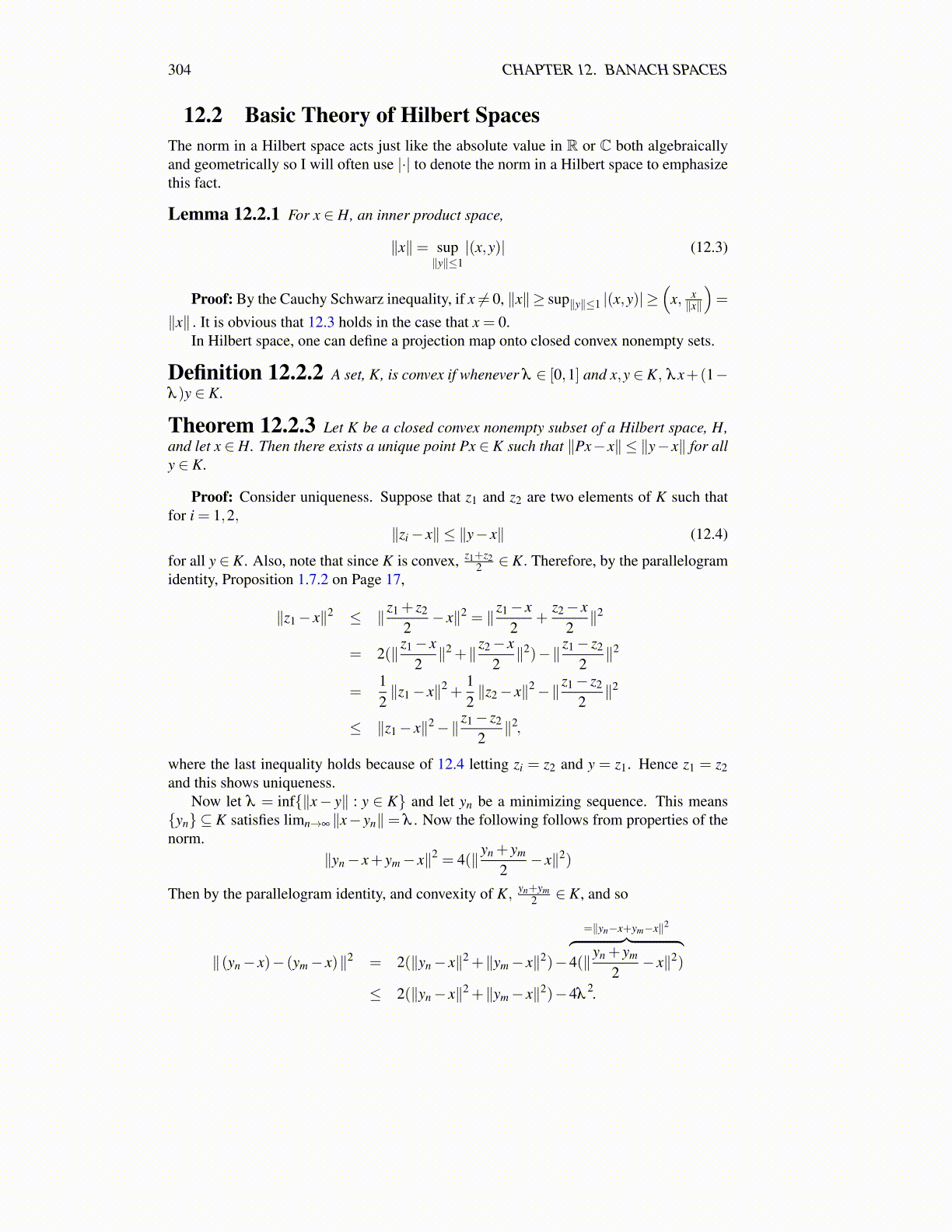
304 CHAPTER 12. BANACH SPACES
12.2 Basic Theory of Hilbert SpacesThe norm in a Hilbert space acts just like the absolute value in R or C both algebraicallyand geometrically so I will often use |·| to denote the norm in a Hilbert space to emphasizethis fact.
Lemma 12.2.1 For x ∈ H, an inner product space,
∥x∥= sup∥y∥≤1
|(x,y)| (12.3)
Proof: By the Cauchy Schwarz inequality, if x ̸= 0, ∥x∥≥ sup∥y∥≤1 |(x,y)| ≥(
x, x∥x∥
)=
∥x∥ . It is obvious that 12.3 holds in the case that x = 0.In Hilbert space, one can define a projection map onto closed convex nonempty sets.
Definition 12.2.2 A set, K, is convex if whenever λ ∈ [0,1] and x,y ∈ K, λx+(1−λ )y ∈ K.
Theorem 12.2.3 Let K be a closed convex nonempty subset of a Hilbert space, H,and let x ∈H. Then there exists a unique point Px ∈ K such that ∥Px−x∥ ≤ ∥y−x∥ for ally ∈ K.
Proof: Consider uniqueness. Suppose that z1 and z2 are two elements of K such thatfor i = 1,2,
∥zi− x∥ ≤ ∥y− x∥ (12.4)
for all y ∈ K. Also, note that since K is convex, z1+z22 ∈ K. Therefore, by the parallelogram
identity, Proposition 1.7.2 on Page 17,
∥z1− x∥2 ≤ ∥ z1 + z2
2− x∥2 = ∥ z1− x
2+
z2− x2∥2
= 2(∥ z1− x2∥2 +∥ z2− x
2∥2)−∥ z1− z2
2∥2
=12∥z1− x∥2 +
12∥z2− x∥2−∥ z1− z2
2∥2
≤ ∥z1− x∥2−∥ z1− z2
2∥2,
where the last inequality holds because of 12.4 letting zi = z2 and y = z1. Hence z1 = z2and this shows uniqueness.
Now let λ = inf{∥x− y∥ : y ∈ K} and let yn be a minimizing sequence. This means{yn} ⊆ K satisfies limn→∞ ∥x− yn∥= λ . Now the following follows from properties of thenorm.
∥yn− x+ ym− x∥2 = 4(∥yn + ym
2− x∥2)
Then by the parallelogram identity, and convexity of K, yn+ym2 ∈ K, and so
∥(yn− x)− (ym− x)∥2 = 2(∥yn− x∥2 +∥ym− x∥2)−
=∥yn−x+ym−x∥2︷ ︸︸ ︷4(∥yn + ym
2− x∥2)
≤ 2(∥yn− x∥2 +∥ym− x∥2)−4λ2.